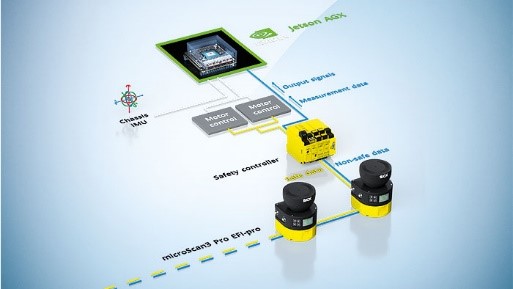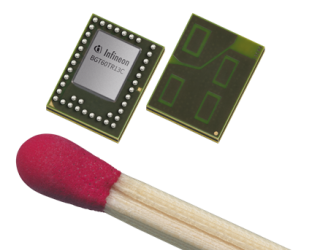Robots that often appeared only in science fiction movies are walking into ordinary people's homes in different forms, lawn mowing robots and floor sweeping robots being the most common. This article will show you current developments and relevant solutions of home-use robots.
Home-use robots become new favorites for families
Instead of "humanoid" robots alone, robots collectively mean various robots with different shapes that can work independently and replace human work. Robots were first mainly used in factories, replacing human beings in some heavy and repetitive tasks. Nowadays, with the progress of technology and the reduction of cost, robot technology has gradually walked into ordinary people’s homes. For example, lawn mowing robots and floor sweeping robots have become popular products to help people deal with repetitive housework.
Common lawn mowing robots and floor sweeping robots are classified as automatic guided vehicle robots (AGV robots). They have the functions of automatically finding paths and autonomously moving and executing tasks. They are composed of parts and components including radar, motor, controller, various sensors (i.e. infrared sensor, distance sensor, collision sensor, fall sensor, etc.), power supply, etc. Of course, by integrating intelligent AI function in the software, they can independently judge the range of weeding/sweeping, avoid obstacles, return to charge, etc., making such robots that can be automatic guided to do housework become new favorites for families. There are already many products relating to AGV robot application. We will highlight several solutions for you.

Lawn mowing robot replaces tedious human labor
Mowing the lawn is a tedious and year-round job. A lawn mowing robot can move autonomously in the lawn or garden and mow the grass perfectly, instead of tedious human labor. ST has introduced the solutions that include a variety of high-performance STM32 microcontrollers, power MOSFETs, gate drivers and integrated motor drivers, and a series of hardware and software evaluation and development tools to help design efficient motor control solutions suitable for various types, as well as motors (e.g., three-phase brushless and brushed DC motors) for moving the wheels and cutting blades of a lawn mowing robot.
In addition, ST also has a series of AC-DC and DC-DC power conversion and battery charging solutions, as well as a wide portfolio of environmental, motion and proximity sensors, very suitable for developing smarter lawn mowing robots. Taking the lawn mowing robot designed by Integra Sources as an example, it uses ST’s STM32F4 MCU series with Cortex-M4 core, uses FreeRTOS for firmware development, uses Microsoft Visual Studio C/C++ with Visual GDB plug-in for firmware implementation, uses Altium Designer IDE for schematic diagram and PCB design, and uses CMOS sensor (camera) with DVP bus. This device can be connected to the cloud (server) using WiFi or 3G connection. The first prototype of this device has wireless module for communication with base station, and LCD with touch screen for GUI. For precise positioning, GPS, accelerometer, gyroscope, compass (magnetometer) and computer vision algorithm are used.
This lawn mowing robot has a graphic interface. It takes only one hour to charge. It also has intelligent autonomous workflow with status monitoring and event alarms. It also has the function of object detection, and can use computer vision algorithm to identify grass and its color. Through the multi-sensor system composed of accelerometer, gyroscope, magnetometer and GPS, it is used to detect the position of the lawn mowing robot and charge itself when the battery is depleted.
Complete solutions accelerate product development
High-quality sweeping robots or lawn mowing robots require high efficiency, long battery life, high reliability and robustness to realize basic area cleaning or cutting functions and secure wireless connection with smart cellphones to set work schedule and make software upgrade.
In response to the above requirements, NXP has also introduced relevant solutions. NXP's MCU has high-performance processing and precise motor control, low-power wireless connection options, and mutual authentication of product security to ensure safe, powerful and efficient robot device design.
For the sweeping robot solution, NXP has introduced i.MX 8M series based on Arm® Cortex®-A53 and Cortex-M4 core, which is responsible for processing audio, voice and video, and i.MX RT1050 Crossover MCU based on Arm® Cortex®-M7 core, high-performance motor/power supply conversion Kinetis KV4x-168 MHz MCU based on Arm® Cortex®-M4 core, and 88W8987 wireless module which is 2.4/5 GHz dual-band 1x1 Wi-Fi® 5 (802.11ac) combined with Bluetooth® 5.2 solution, or IW416 wireless module which is 2.4/5 GHz dual-band 1x1 Wi-Fi® 4 (802.11n) combined with Bluetooth® 5.1 solution. JN5189/88 (T) and QN9090/30 are used in the Home Area Network (HAN). JN5189/88 (T) is a high-performance and super low-power MCU used for Zigbee® and with built-in NFC option, i.e., Thread protocol, and QN9090/30 is a low-power Bluetooth MCU with Arm® Cortex®-M4 CPU, energy efficiency, analog and digital peripherals, and NFC tag option. In addition, the robot is also equipped with parts and components such as PMIC, load switch, security (EdgeLock discrete), temperature sensor, LED driver, accelerometer, motor driver, flow/pressure sensor, real-time clock, etc.
In terms of the lawn mowing robot, NXP uses i.MX RT1050 Crossover MCU with Arm® Cortex®-M7 core and i.MX 7ULP ultra low power processor with graphics, 88W8987 or W416 wireless module that is the same as the solution used in the above sweeping robot, and JN5189/88 (T) HAN solution. In addition, the robot is equipped with components such as AC/DC converter, PMIC, security (EdgeLock discrete), temperature sensor, motor driver, LED driver, real-time clock, etc.

Autonomous robot solution with AI capability
In addition to floor sweeping robots and lawn mowing robots, a variety of robots are also used in factories, warehouses and hospitals. Robots combined with artificial intelligence have the ability to perceive, think and act in the workplace. The Isaac robot platform introduced by Nvidia brings this level of AI into these robots, including AGV and Autonomous Mobile Robot (AMR).
Today's production and logistics environment features mobile platforms, which means greater flexibility and higher efficiency to increase productivity by avoiding collisions and downtime. SICK supports Nvidia’s Isaac robot platform with rugged sensors and intelligent software to ensure safe, autonomous and cost-effective operation of AGV and AMR. As an important part, the mobile platform can keep moving by adjusting the driving speed according to the situation, and the data provided by sensors can also be used for positioning and navigation.
SICK's EFI-pro security system can provide intelligent protection of AGV, robots and other challenging applications. EFI-pro network technology based on industrial Ethernet can quickly exchange and transmit safe and non-safe data in all communication levels. As the central component, the EFI-pro gateway can ensure the safe and rapid integration of innovative sensor solutions from SICK and the direct integration of robot control into Flexi Soft safety controller through EtherNet/IPTM CIP SafetyTM. Therefore, Safe EFI-pro system is a key driving factor for the implementation of Industry 4.0.
Safe AGV Forklift is an efficient safety solution for AGV with lifting forks and can be easily installed on automatic forklifts with driving wheels. The safety laser scanner switches the protection area independent of speed and direction, which can prevent stops and reduce component wear. The solution prevents standard-compliant automatic loading and unloading. With the use of the safety encoder, a vehicle is allowed to continue driving while the forklift descends at a safely reduced speed, and it is possible for fully automatic and safe operation of the AGV with lifting forks.

Accurate ranging by laser ranging sensor
One of the key components in robot application is various sensors used to detect the environmental conditions around robots. The VL53L1X introduced by ST is the most advanced time-of-flight (ToF) laser ranging sensor, which enhances the ST FlightSense™ product line. It is the fastest miniature ToF sensor available on the market. The distance of accurate ranging can reach 4 m and ranging frequency can reach 50 Hz. Available in reflow-solderable miniature package, it has a Single Photon Avalanche Diode (SPAD) receiving array with integrated lens, a 940 nm invisible Class1 laser emitter, physical infrared filters and optical component to achieve the best ranging performance under various ambient lighting conditions through a series of cover window options.
Unlike traditional infrared sensors, VL53L1X uses ST’s latest generation ToF technology, which allows absolute ranging regardless of the target color and reflectance. It is also possible to program the size of the region of interest (ROI) on the receiving array and provide multi-area operation control from the host, thus reducing the field of view (FoV) of the sensor.
The VL53L1X is a fully integrated miniature module only 4.9x2.5x1.56 mm and built-in low-power microcontroller running advanced digital firmware, which is pin-to-pin compatible in the VL53L0X FlightSense™ ranging sensor for fast and accurate long-distance measurement. The full FoV is typically 27°, for which it can be hidden behind many cover window materials. It also offers software drivers and code examples for turnkey ranging. It uses a single power supply (2v8), has an I²C interface (up to 400 kHz) and shutdown and interrupt pins.

Ultrasound sensors have excellent performance
In ranging applications, ultrasound sensors also have excellent performance. Ultrasound sensors emit ultrasound in the air, reflect it back from objects, and then reflect sound waves to be received by the sensors. This technology can be used to detect objects for burglar alarms and automatic doors, and for ranging in automobile parking assistance system, as well as for robot ranging.
The continuous development of Murata's unique piezoelectric ceramic technology over the years has enabled the company to commercialize a variety of compact high-performance ultrasound sensor product lines. Murata has introduced a variety of ultrasound sensors, including open architecture ultrasound sensors, which are characterized by a composite oscillating body that combines an oscillator (integrating a metal plate and a piezoelectric ceramic) with a resonator. The main body is elastically fixed on a base and accommodated in a housing. The resonator is funnel-shaped, effectively radiating ultrasound generated by the oscillating body into the air and effectively concentrating ultrasound from the air at the center of the oscillator. Sound pressure is the most important parameter of open architecture ultrasound sensor. In ranging application, the higher the sound pressure of ultrasound sensor, the longer the range of sensor.
Surface Mount Device (SMD)-type measure intermediate range, since it control sound pressure loss because of miniaturization. Miniaturized SMD-type ultrasonic sensor has succeeded in minimal mounting space and enabled improved flexibility for design.

Radar can provide sub-millimeter accuracy in ranging
Radar has proven to be a powerful sensor for short-range positioning and vital sign tracking in consumer electronics, healthcare, surveillance, driver assistance and industrial applications. Infineon has also introduced an innovative XENSIV™ 60 GHz radar sensor for relevant applications. It can track sub-millimeter motion at high speed and accuracy. It is installed on a chip that can be produced on a large scale and can be used across a wide range of mobile, wearable and stationary devices. With its small form factor and low power consumption, Infineon's highly integrated radar sensor solution brings innovative and intuitive sensing features to many applications. Radar supports existing applications while providing features that enable completely new use cases. It can measure horizontal and vertical velocity, range and angle for precise position mapping and 3D tracking.
The robot industry is booming, creating a lot of new opportunities in manufacturing, logistics and other fields. Whether industrial robots, cooperative robots or AGVs, robots are becoming more and more mobile, bringing great potential for flexibility and efficiency to industries other than traditional wafer fabs, including e-commerce automation and logistics. Infineon has introduced complete solutions for robot applications. Whether power supply management, motor drivers, communications, environmental sensing and position and condition sensors, or customized safety and security solutions, Infineon's semiconductor solutions will continue to be key promoters of a wide range of robot features and applications.
Conclusion
At present, house-use floor sweeping/lawn mowing robots have become one of the most popular household appliances, with amazing market development potential. The solutions described in this article will help you speed up the design of relevant products and seize market opportunities as soon as possible and are worthy of your further understanding and reference.


